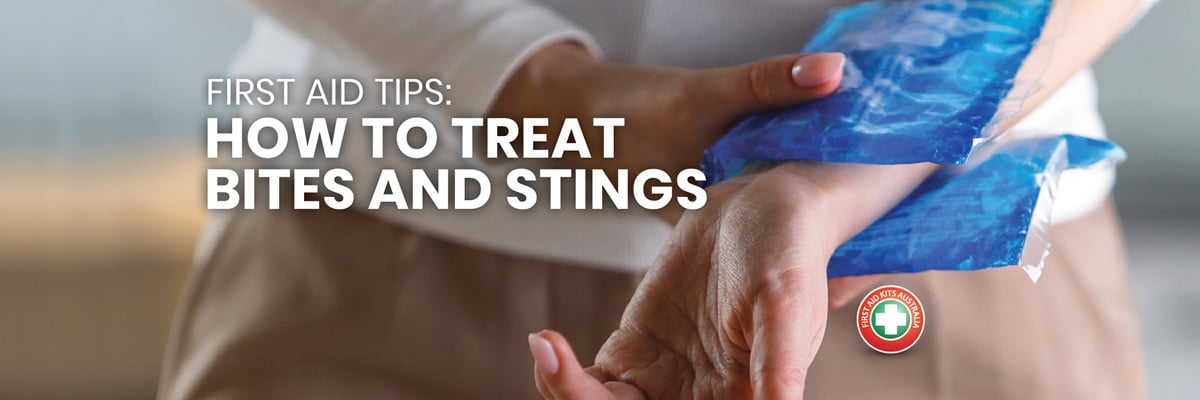
Easter Safety Sale
1 March 2021
Harries (Bondi Rescue) joins our team as Brand Ambassador
6 April 2021If you live in Australia, knowing First Aid for bites and stings is key, as you may encounter all sorts of dangerous creatures.
Here are 3 important things to know:
Bites or stings can cause a severe allergic reaction (anaphylaxis) in some people. In this case, administer adrenaline via an autoinjector and call immediately 000.
As it is difficult to know if a snake bite is dangerous or not, always treat a snake bite as a venomous bite and manage it as an emergency.
Call triple zero (000) for an ambulance in an emergency.
| Bites | Sting | |
|---|---|---|
The insect pierces the skin to suck blood. They can infect you with diseases. | An animal sting injects toxic venom to your system and can produce an allergic reaction. |
In this article we will cover 4 different types of treatments for the most common land and marine animals bites and stings:
Pressure Immobilisation Technique
Vinegar
Heat therapy
Cold compress
Pressure Immobilisation Technique
Use this treatment for:
Any Snake Bite (including sea snakes)
Seek immediate help and apply pressure bandaging and immobilization.The signs of a snake bite are two punctures closed together or a single or multiple small straight lacerations/ scratch.
Symptoms: the bitten person may complain of a headache, nausea and/or vomiting, abdominal or chest pain, drowsiness, blurred or double vision, breathing difficulties, cold, pale skin.
Funnel-web spider and mouse spider bites
The person bitten by a Funnel- web spider ( also called Sydney spider) will develop symptoms fast. Symptoms include pain, numbness around the mouth or spasms of the tongue, nausea and vomiting, and a series of physiological responses that the sympathetic nervous system initiates in response to the venom: profuse sweating, salivation, lacrimation (tears from eyes) and piloerection (goose-bumps).Blue-ringed Octopus bite
One of the most cute-but-deadly sea creatures. While they are common in Australia, they are not easy to find. They are timid and prefer to stay away from humans, but will attack if touched.Do not be deceived by their size, while this creature is only 10 to 20 cm long from tentacle tip to centre, they are lethal enough to kill 26 adults!
Cone shell sting
Another small but lethal sea creature. The sting usually occurs when swimmers, snorkelers or divers pick them up (because they are pretty).Sings and symptoms of a cone shell sting are similar to the Blue-ringed Octopus, with localized burning and sharp stinging symptoms. Pain can be intense and produce numbness and tingling to the wounded area. In severe cases, the numbness progress to muscle paralysis producing finally respiratory failure, resulting in death.
As venom is injected beneath the skin and can spread fast, the priority is to minimize movement of the person and the bitten area/limb by applying Pressure Immobilization and Bandaging.
If the person is conscious
Rest, reassure and calm the patient
Apply a firm broad heavy elastic or crepe bandage over the area of the bite. Start at the toes or fingers and bandage all the way up the affected limb, past the joints to the top of the limb.
Note: if you don’t have a bandage, use other flexible materials, i.e. tear up towel, clothes or sheets into strips.Mark the bitten area as this will assist doctors to locate the bite site
Immobilize the limb with a splint or a sling. You could use a belt for a sling, bind one leg the other with the bandage, or a folded newspaper for an arm splint
If you can – and if it’s safe to do so – take a photo for identification purposes, in case antivenom is required.
If the person is unconscious
Apply DRSABCD monitoring and caring for Airway and breathing as per basic life support.
Then treat as for a “Conscious” patient
The bandage should be tight enough so that it is difficult to slide a finger between the bandage and skin.
Here are photos of bandages you will find in a First Aid Kit.
| Warning | NATIONAL POISONS INFORMATION CENTRE | |
|---|---|---|
DO Not wash the bitten area, as the venom can be Do Not apply tourniquet Do Not remove the bandage at any time | 24 hours a day Australia Wide PH: 131 126 (Free Call) |
Vinegar
Use Vinegar to stop the tentacles from stinging as a treatment for the sting of Box jellyfish, Irukandji, Morbakka, or other tropical jellyfish sting
The signs and symptoms of jellyfish sting are:
Rapid onset of excruciating pain, described as being ‘hit with a whip’
Tissue necrosis (death of tissue)
Cardiac and respiratory function severely affected
Did you know that…
* Jellyfish are the oldest multicellular animals on the planet
* Jellyfish don’t have brain… or heart or lungs, actually there is not much to a Jellyfish giving that they are between 85% and 98% water. If they wash up on the beach they’ll almost disappear as their water evaporates.
* Box Jellyfish is the most venomous marine animal!
* They have gone to space! In 1991, moonfish jellyfish travelled into outer space on the Space Shuttle Columbia so that scientists could examine how microgravity affected them. The jellyfish multiplied in space. When they came back to Earth, the scientists discovered that the space-born jellyfish couldn’t figure out how to deal with gravity.1
Treatment
Apply generous amounts of vinegar into the affected area for at least 30 Seconds.
Do not use fresh waterUse icepacks or anaesthetic cream to reduce the pain
See medical attention
Heat Treatment
This treatment is recommended for NON Tropical Jellyfish and other marine animals, such as bluebottle, stonefish, lionfish, stingray, crown-of-thorns starfish, et.
Treatment
Before treating the stung person, ensure the water is hot but can be tolerated and will not burn the area.
Place the stung area in hot water for 20 minutes
Remove briefly and then immerse the area in hot water again
Repeat this cycle until pain eases
Seek medical attention if symptoms are severe
Cold Compress
This treatment is advised for many land animals bites: spiders, bees, wasps or ant sting, tick bite, scorpion or centipede sting. Also, for some jellyfish stings.
Bees, Wasp and Ant bites
In the case of a Bee bite, try to remove the sting with your nails by scraping it.
The signs and symptoms will appear immediately and the person will complain of intense localised pain and swelling. If the person is allergic to this insects’ bites, he/she may enter an anaphylactic shock. If that the case, use an autoinjector adrenaline pen and call 000 immediately.Tick Bite
If the tick has dig into the skin, try to remove it using tweezers and pulling straight out aiming to remove the entire body. Do not use alcohol or other liquids to kill the tick before removing it as it may release more poison.
Treatment
Apply a cold pack to the bitten or stung area for 15 minutes
Repeat if pain continues
Seek medical attention if symptoms worsen
How to Prevent bites and stings?
The majority of insects, bugs and even snakes are quite harmless, but if the feel threatened they will bite or sting. Prevention is always the best medicine, so here are some valuable tips:
Use protective clothes and insect repellent when you are outdoors
Do not touch or try to grab animals or insects
Cover food and drinks
Tightly close rubbish bins
Have a First Aid Kit in your car or take one while doing outdoor activities
Learn First Aid so you can save lives





